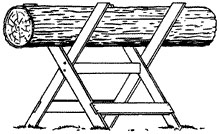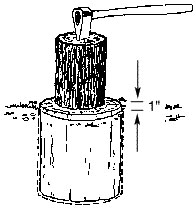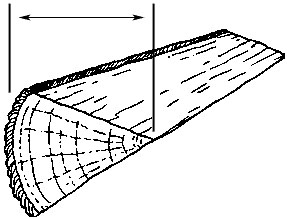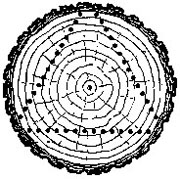This guide describes one strategy for people who cut and burn one or more cords of wood yearly. If you cut and prepare wood, have a plan, whether it be this one, a modification, or one of your own. A well-planned, one-person operation reduces the work required to produce a cord of well-prepared firewood. It also should increase the efficiency of your stove and reduce creosote production and air pollution.
Logs or cutting stock
Logs should be cut in multiples of the desired final length. For example, 16 inches, plus or minus 2 inches, is a popular length that will fit most stoves. When cutting logs, remember that they can't be very long if one or two people do most of the handling. Although it works well in conventional fireplaces, cut out crotch wood. Do not accept elm unless that is all you can get and you don't mind a lot of extra effort when it comes to splitting the wood. Shorten the length of elm cordwood by 2 inches or more.
Cutting to length

Large diameter pieces of wood should average 16 inches in length. You will need a sturdy sawbuck (which you can make) with cross pieces 16 to 20 inches apart (Figure 1). The last cut on any log should be made between the cross pieces; first, a down cut until it just starts to pinch and then an up cut to sever the two parts. Be sure your sawbuck allows clearance from the bottom for your saw.
Many people have had good luck with an electric 14-inch chain saw for bucking the logs. Electric saws are inexpensive and have the advantage of turning on and off easily. The motor provides ample power and has proven to be a sturdy machine.
As an option, you may choose to cut firewood-length logs with a gas-powered field saw. Instead of using a crossbuck, cut logs on the ground and simply roll them half a turn for the final cut.
Splitting your wood
Splitting wood requires more skill than any other step in preparing stove wood. To do a good job, you must become fairly skilled — that is to say, accurate — at swinging a splitting maul. You must also become skilled at interpreting the knots and cracks in a piece of wood to determine where to hit a log for the best results and with the least amount of effort.
Several splitting tools are on the market today. For limited production (less than 10 cords a year), studies have shown the best results are achieved with a standard 8-pound splitting maul.
You will also need a splitting block. One suggestion is to treat the block with a wood preservative and bury it with the top protruding about 1 inch above the ground (Figure 2). Another idea is to use two auto tires. Placing the tires over the block holds wood pieces in an upright position and prevents split pieces of wood from flying off.
Before starting to split the wood, decide on a maximum single cross-section dimension (Figure 3). Ideally, this dimension should be slightly smaller than the smallest dimension of your stove door. For example, if a 6-inch maximum splitting dimension has been selected, all round pieces greater than 6 and up to 12 inches in diameter should be split into four or more equally sized pieces. It is a good idea to split pieces less than 6 inches in diameter because this increases the exposed area of the wood. The greater the surface area, the faster wood dries and the better it burns. Pieces 3 inches and smaller should be used unsplit. Pieces wider than 12 inches need splitting off at the outside edge (Figure 4). Split the remaining core piece so the chunks do not exceed the maximum size specified.



Splitting strategy
Observing grain direction and knot placement for the easiest way to split wood is called reading the wood. Here are some wood-reading tips:
- Branch angle or bolt taper shows which end of the wood piece was closest to the tree top. Invert this piece of wood (place the top side down). This allows splitting with the longitudinal grain.
- If the piece has a large knot, place the blows perpendicular to the knot. If a parallel hit is necessary, offset the blow from the knot as much as possible.
- Wood splits easier when green.
Dimension example
If the smallest dimension of your stove door is 6 inches, split your wood following these guidelines:
- Less than 3 inches in diameter — Do not split (use as is).
- 3 to 6 inches in diameter — Split in half.
- 6 to 12 inches in diameter — Split into four equal pieces.
- Greater than 12 inches — Split three or more pieces off the outside edge. Split the remaining core piece to produce pieces within the 6 inch maximum rate used in this example.
If you determine that your maximum splitting dimension is 8 inches, you would need to substitute 8 inches for 6 inches and 16 inches for 12 inches in the above listing, and so on for other maximum dimensions.
Stacking and drying
Stack cord wood in a sunny spot where the wind can move freely through the stack. If it is practical to do so, cover the wood pile to protect it from rain and snow.
Stack wood in the spring for use the following winter. This timing will help ensure the wood is dry enough to burn when winter arrives. The ideal moisture content for firewood is 20 percent or less. Fresh wood often has a moisture content of 50 percent or more, and it takes at least one drying season (spring through fall) to dry. When people have poor results with their wood burning stove, it is often because they waited until late summer or early fall to stock their wood supply, and the wood they are using is too green.
Operating the stove
It is not the purpose of this guide to discuss how to operate a wood stove. However, in addition to properly preparing the wood, you need to develop a good, safe stove operation technique. For the most efficient results, use a small stove and burn hot, which means maintain the fire and cut it back to a smolder as infrequently as possible.